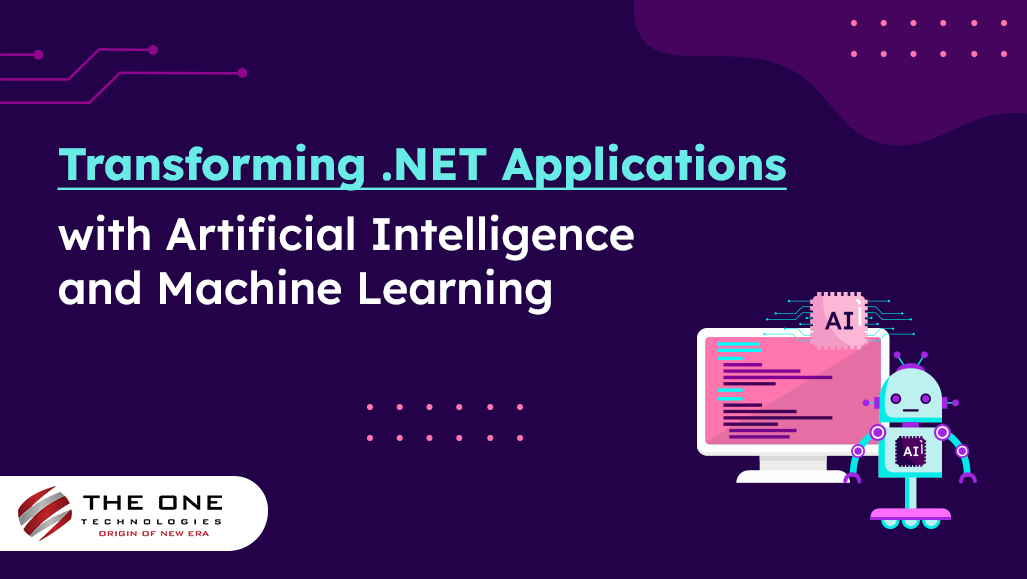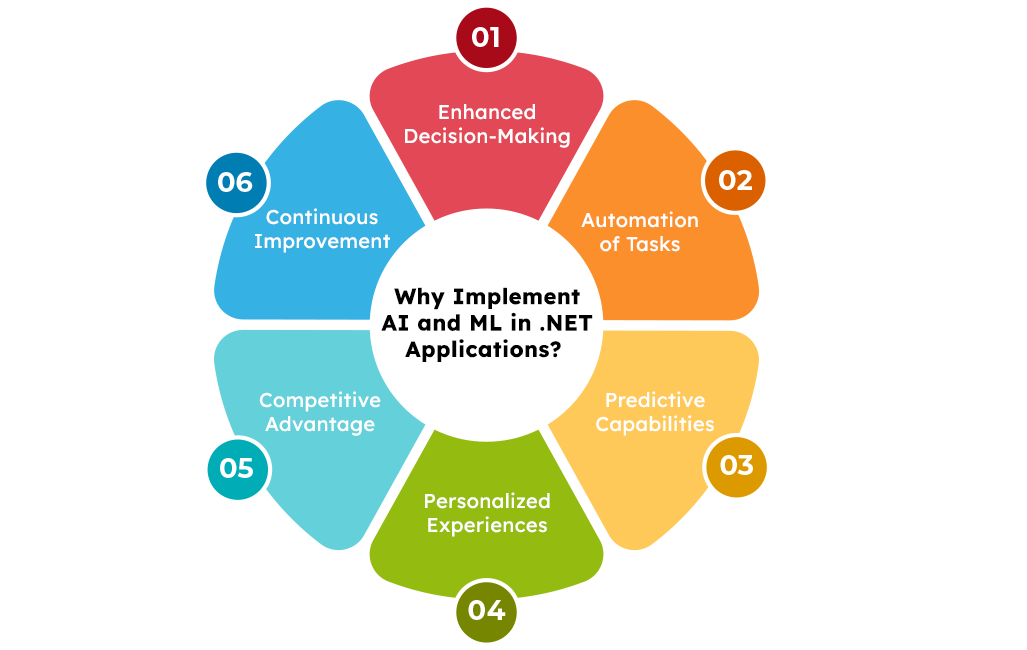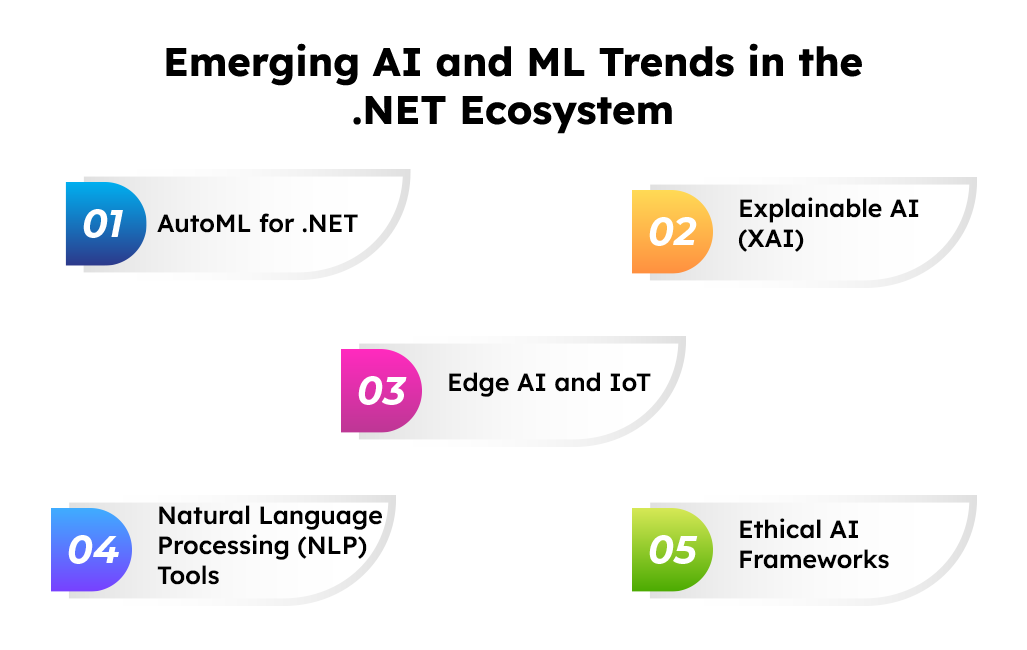Enhancing .NET Apps with AI and Machine Learning

Table of Content
- Introduction
- Why Implement AI and ML in .NET Applications?
- How to Integrate Al and ML into .NET Apps?
- Essential .NET Frameworks and Libraries for AI and ML Applications
- Emerging AI and ML Trends in the .NET Ecosystem
- Final Thoughts
Introduction
One of the most important aspects of fostering innovation and improving user experiences is the use of AI and ML in software applications. Leveraging this technology offers an exciting opportunity for any .NET development company looking to remain ahead of technology trends to turn their apps into intelligent, adaptable systems.
This post examines the integration of AI, ML, and.NET programming, providing useful techniques for effectively using these state-of-the-art tools. .NET developers may achieve new capabilities in their applications, such as task automation, gaining insightful knowledge, and providing users with tailored experiences, by grasping the concepts this technology.
So, let's see how your .NET applications can transform with Artificial Intelligence and Machine Learning and help you to drive innovation and deliver exceptional value to your clients and end-users.
Why Implement AI and ML in .NET Applications?
There are several major benefits to integrating AI and ML into .NET applications, such as:

1. Enhanced Decision-Making
Large-scale data processing and analysis are strengths of AI and ML algorithms, which allow them to extract insightful information. These technologies can be used to enable data-driven decision-making during the process of NET application development. This lets your app decide wisely based on trends and patterns found by AI models.
2. Automation of Tasks
The requirement for manual intervention can be decreased by using AI and ML to automate repetitive operations and procedures. By streamlining processes and increasing productivity, this automation frees up developers to concentrate on the imaginative elements of dot Net application development.
3. Predictive Capabilities
AI and ML models are able to forecast future patterns or outcomes by learning from past data. You may create systems that anticipate user requests, optimize resource allocation, and proactively handle possible issues by incorporating predictive analytics into development of web application in ASP.NET.
4. Personalized Experiences
Recommendation engines and content delivery and driven by AI have the potential to greatly improve user experiences. .NET apps can personalize interactions, content, and services to each user by studying their behavior and preferences; this results in increased user happiness and engagement.
5. Competitive Advantage
.NET apps may provide excellent features like anomaly detection, computer vision, and natural language processing by utilizing AI and ML capabilities. These cutting-edge features can set your apps apart from the competition and draw in additional users or clients.
6. Continuous Improvement
With the ability to continuously learn from fresh data and user interactions, AI and ML models enable .NET apps to evolve and get better over time. Applications can remain relevant and adaptable to changing needs and user preferences thanks to this continual learning process.
How to Integrate Al and ML into .NET Apps?
Learn effective strategies to seamlessly integrate AI and ML capabilities into your .NET applications, leveraging powerful frameworks and APIs. Have a look at the below-mentioned image and gain insights and visual guidance:
_638561057617917082.png)
1. Define Use Cases
Start by identifying particular use cases where your.NET application can benefit greatly from the integration of AI and ML. Personalized recommendations can improve user experiences, repetitive operations can be automated, and predictive analytics for consumer behavior can be implemented. Establishing precise use cases guarantees that AI/ML integration is in line with company goals and aids in prioritizing efforts.
2. Choose AI/ML Frameworks
For integration to be effective, choosing the appropriate AI and ML frameworks that interact with.NET is essential. Think about using Python-based frameworks like PyTorch or TensorFlow with interop libraries for leveraging TensorFlow models. Select the framework that best meets your skill level, scalability needs, and use case.
3. Data Collection and Preparation
Efficient data collection and preparation are necessary for building trustworthy and accurate AI/ML models. Collect pertinent datasets, handle missing values, clean and preprocess the data, scale or normalize the features, and divide the data into training and testing sets. Building strong models that provide insightful information within your NET application development process as it requires high-quality data.
4. Model Development
Choosing the right algorithms depending on your use case and putting them into practice using the chosen framework are the first steps in developing machine learning models. Using the prepared data, train the models, adjust hyperparameters for best results, and assess the efficacy and accuracy of the models. To get desired results, iteratively improve the models based on feedback and validation findings.
5. Analyze the Layout
Examine your .NET application's architecture and layout before integration to ascertain how AI and ML components can work together. Think about things like performance, scalability, data flow, and possible effects on current features. Make sure the AI/ML integration doesn't add needless complexity and is in line with the overall application architecture.
6. Integration with .NET
Placing trained models, putting prediction or inference logic into place, and making AI-driven features accessible through user interfaces or APIs are all necessary steps in integrating AI and ML components into .NET applications. Utilize the libraries or SDKs offered by frameworks to include AI/ML features straight into your .NET program. To guarantee smooth communication between modules and the remainder of the application, extensively test the integration.
7. Monitoring and Maintenance
Create monitoring systems to track AI/ML model performance in real time after deployment. Track performance indicators including latency, accuracy, and resource usage to spot possible problems or drift. To maintain relevance and dependability, retrain and update models on a regular basis using fresh data. Maintain and update AI/ML components on a regular basis to keep them current and in line with changing business requirements.
Essential .NET Frameworks and Libraries for AI and ML Applications
_638561078799975442.png)
1. TensorFlow
Google created the popular open-source machine learning framework TensorFlow. It allows developers to use TensorFlow models directly in their .NET apps, enabling them to do tasks like computer vision, natural language processing (NLP), and deep learning.
2. PyTourch
Another popular deep learning system with a simple API and dynamic computational graphs is PyTorch. Within the .NET environment, developers may effectively create and train neural networks by integrating it with frameworks like TorchSharp.
3. ML.NET
Microsoft's open-source machine learning platform, ML.NET, was created especially keeping .NET developers in mind. It offers a wide range of tools and APIs for creating unique models, preparing data, and smoothly incorporating ML functionality into .NET applications.
4. OpenNN
A strong library for neural network programming is OpenNN (Open Neural Networks Library). It is primarily built in C++, but it is also available to .NET developers through a .NET wrapper so that they can build and implement neural network models for a range of uses.
5. Dlib
A flexible C++ library, Dlib contains utilities for image processing, computer vision, machine learning, and numerical optimization. Because of its .NET coupling, developers may use its features like object identification, facial recognition, and clustering.
6. ONNX
An open representation format for deep learning models called ONNX makes it possible for various frameworks to work together. To facilitate the smooth execution of models learned in frameworks such as TensorFlow or PyTorch, .NET developers can include ONNX models into their applications by utilizing the ONNX Runtime.
7. LightGBM
Large datasets can be handled with extreme efficiency using LightGBM (Light Gradient Boosting Machine), a scalable and quick gradient boosting framework. It can be applied to ranking, regression, and classification tasks. It is available to NET developers through libraries such as LightGBM.NET, which enable effective model training and inference.
Emerging AI and ML Trends in the .NET Ecosystem
Discover the latest AI and ML trends shaping the .NET ecosystem, from advancements in deep learning frameworks to the integration of AI-driven automation.

1. AutoML for .NET
With the growing popularity of AutoML (Automated Machine Learning) solutions, developers may now automate the model selection, hyperparameter tuning, and deployment processes. To improve the efficiency of the machine learning workflow, keep an eye out for developments in AutoML solutions designed especially for .NET developers.
2. Explainable AI (XAI)
Building reliable AI systems is becoming more and more dependent on explainable AI, which focuses on improving the interpretability and transparency of AI models. Anticipate advancements in XAI methodologies and libraries within the .NET framework to facilitate developers' comprehension and justification of model determinations.
3. Edge AI and IoT
The requirement for AI models to function well on devices with limited resources is being driven by edge computing and the Internet of Things. Real-time inferencing and device-level decision-making will be made possible by optimizing AI models for edge deployment within the .NET ecosystem.
4. Natural Language Processing (NLP) Tools
NLP skills are necessary to develop text analytics and conversational AI systems. New libraries and tools that help with NLP tasks like entity recognition, sentiment analysis, and language translation within apps are something that .NET developers should look forward to.
5. Ethical AI Frameworks
It is expected that ethical AI frameworks and principles will emerge in the .NET ecosystem because of growing concerns about bias and ethics in AI. These frameworks will assist programmers in creating ethical AI systems that place a high value on privacy, responsibility, and openness.
Final Thoughts
Artificial intelligence and machine learning combined have the power to completely transform.NET programs, opening up new possibilities for creativity, effectiveness, and user involvement. Businesses may develop intelligent applications that automate processes, offer predictive insights, and provide users with individualized experiences by utilizing AI and ML. Organizations trying to stay ahead of the curve should think about utilizing these game-changing technologies as the need for intelligent software solutions only grows. If you're ready to enhance your .NET applications with AI and ML capabilities, don't hesitate to hire ASP.NET developers skilled in implementing these cutting-edge technologies to drive your digital transformation forward.



_638561057595141205.webp)
_638561078799682384.webp)





